SEGMENT III: Mixing It Up In Laie
In Part 3 of our series of Laie during World War II, we learn from the recollections of Laverne Pukahi, Joe Ah Quin and Gladys Pualoa Ahuna about how the locals entertained themselves, what it was like to be surrounded by numerous military camps and we learn about the great tidal wave of 1946.
One Place, Used In Many Different Ways
Things began to calm down in Laie after the first couple of years, though things were never the same. It was the beginning of the big change that effected how everyone worked, played and lived.
There was an old social hall near the corner of Wahinepee and Loala Streets, close to where the Hukilau Cafe now stands. During the war they had concerts and dances every Saturday night. Anybody that wanted to perform simply needed to sign up, whether it was comedy, singing, the hula, or whatever talent they wanted to share. When the entertainment was over, the chairs were pulled to the side of the wall and John Broad brought in his orchestra, which usually included three saxophones, a stand-up bass, and the piano played by Aunty Marie.
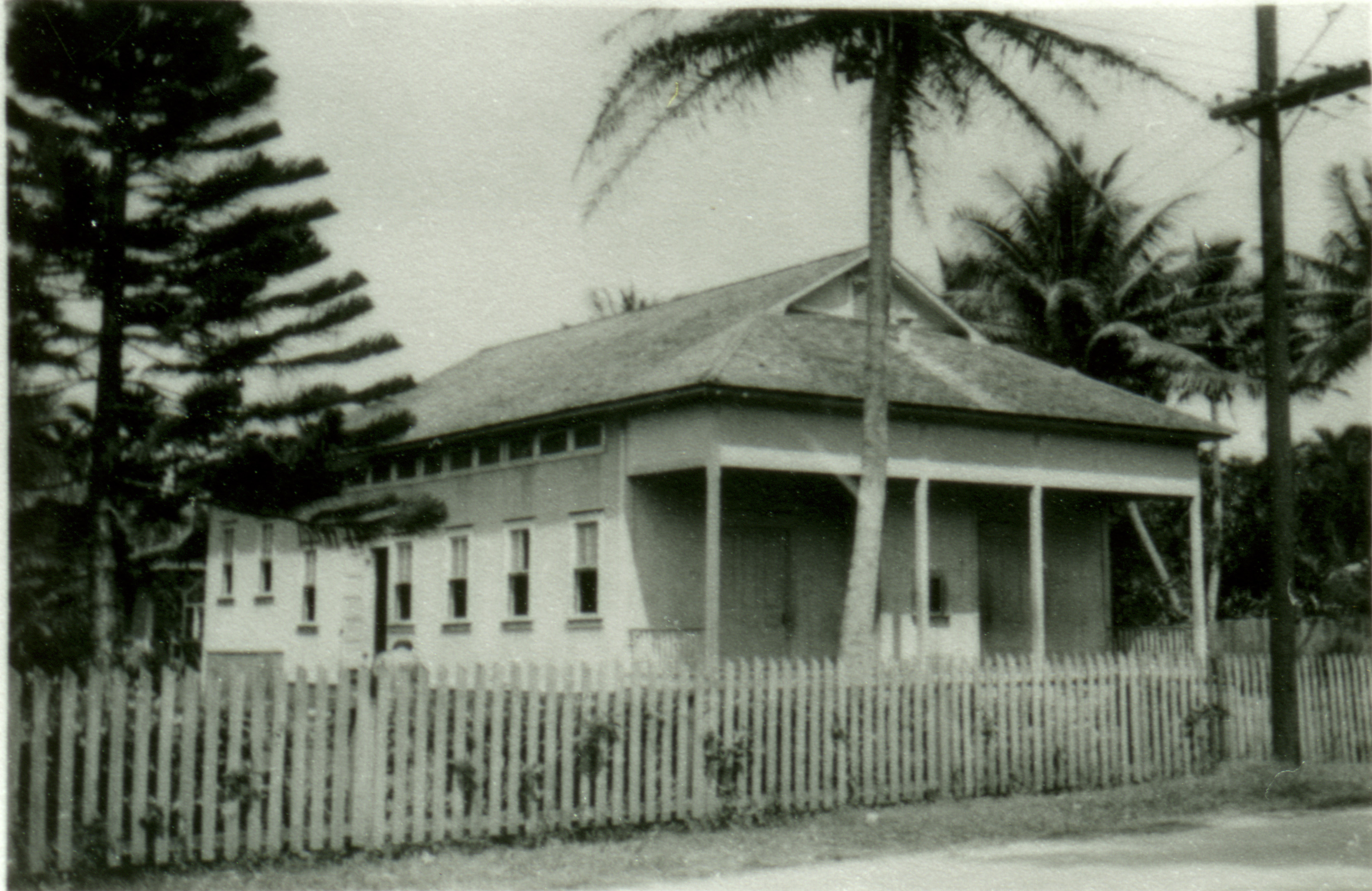
The Social Hall on Loala Street, Laie. Courtesy of BYU-H Archives and Special Collections
Back in 1940, the LDS chapel by the Laie Temple had burnt down. Because of the war, rebuilding a chapel had to put on hold, so the social hall was used for worship services on Sunday.
“They would dance until 11:00 o’clock at night,” Gladyys explained, “then clear off the stage, put all the chairs back and get ready for church the next morning. We had our stake conferences there. We had weddings there. We had funerals there. We had everything there”.
There was a certain amount of animosity between the young men of the city and the soldiers during the dances. After all, there were over 1,000 soldiers around Kahuku. Being such a small town, there were very few local girls, and even fewer civillian young men. Things could get a bit tense, and sometimes there were fights. But most of the memories were fond ones.
Soldiers, Soldiers Everywhere
Immediately after the attack on Pearl Harbor, the 19th infantry was camped at La’ie. They were all spit and polish, which impressed the young Gladys. After they pulled out, the 298th came in. Up until that time the 298th, which was made up of local boys who had been drafted or recruited, had been training at Schofield Barracks, which was in the middle of the island.
“When these boys came,” Gladys explained, “they were so black from being out in the sun. They were the farthest thing from an Army. They wore tank tops, fatigues pants, and slippers. But they became so liked in this community. “
Recalling that her house was headquarters for B Company, Gladys remembered that every weekend there would be 10 – 13 boys sleeping on the floor…. legs and arms all over the place. “We never locked our doors and my father was always there. We had five girls, but we were always safe. Out of respect they never smoked around us. And if they drank, they knew they couldn’t stay.”
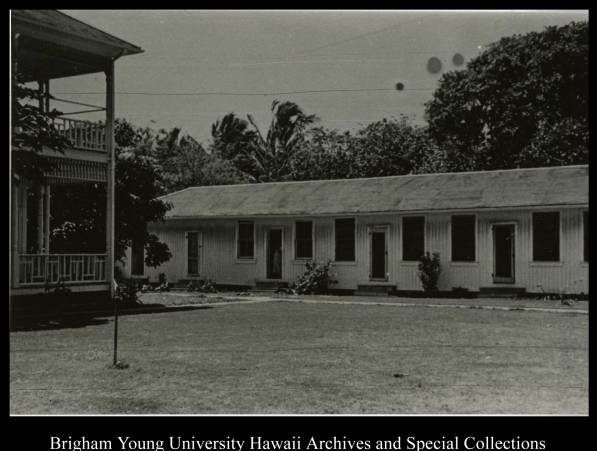
Laverne shared that their barracks were up Stable Road, near the stables for the sugar cane plantation.
After some further training and preparations, the 298th was pulled out to go to the front. “But our state legislature contacted the Federal Government, explaining that the 298th was all of our local boys.If they went to war, it could decimate culture, so from the middle of this cadre (group of ships), the 298th was pulled out and reassigned to Guadalcanal.”
This was not to say that the 298th lacked the skill or courage for battle. Years later Gloria remembered attending a presentation about the war where a colonel shared that if the 298th had gone to the battle front, they would have been a mighty presence. “They were so carefree,” she remembered him stating. “If they had to go, they would have just gone. They would have never flinched”.
Up above the cane fields in Kahuku towards the mountains, Joe Ah Quin explained, was another very large military camp. Then there was Marconi Air Field, where the 6th Air Corp was housed. The entire base was a city of houses. “They kept everything immaculate. So clean” he described.
“Let me tell you,” Gladys added, “those boys were trouble!”. This is not to say that they were not excellent soldiers, but their reputation during their down time was not as favorable.
April Fools of 1946 Was No Laughing Matter
Joe, Laverne and Gladys then reminisced about the 1946 tidal wave. “It came on April Fool’s Day, 1946”, Joe began. “When the tidal wave hit, it came in at Marconi. All these bunkers, I mean heavy duty cement structures, were tossed all over the place”.
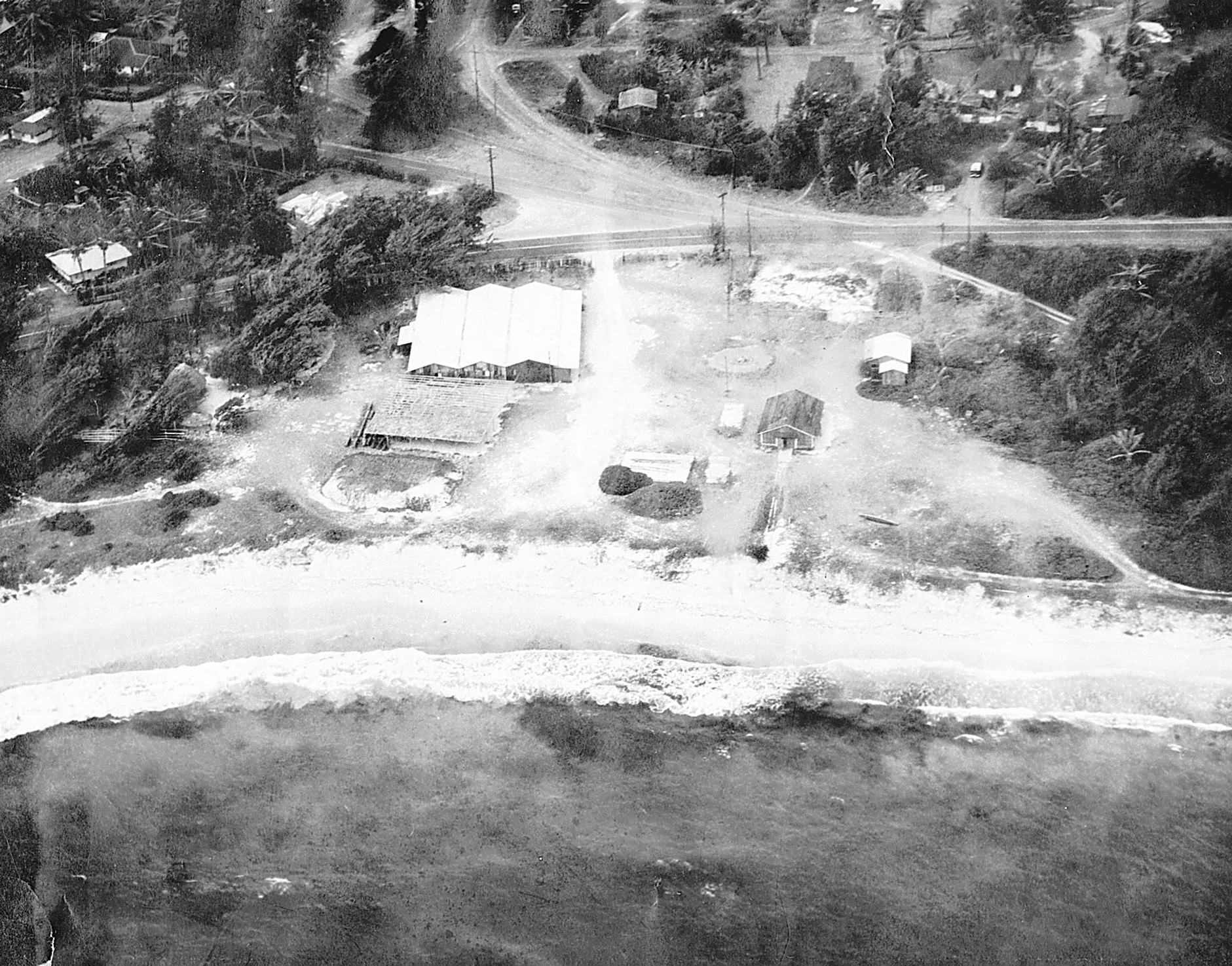
Laie Beach (later named Hukilau Beach) showing the bakery, the various boat houses and Kamehameha Hwy. Courtesy of BYUH Archives and Special Collections
“My father had a boathouse at Laie Beach” (now renamed Hukilau Beach),” shared Laverne. “Hamana Kalili (the local legend famous for the Shaka wave) had his boat house there too. (Those buildings) all washed away. They were gone.”
Although the wave did not reach high into Laie, it was powerful. At that time the shoreline was quite a bit farther out. The water washed up to just above the highway.
Laverne told how as the water rushed in, it hit a bakery on the makai (ocean) side of the highway. When the wave came, it went straight through the building, shattering all of the glass. There were buns and equipment strewn everywhere.
Gladys remembered that her father came home yelling “tidal wave, tidal wave”. Her mother took the children up the mountain, but Gladys didn’t join them. “As soon as they left I was out the gate and down the walkway past the school. I jumped over the wall and found myself ankle deep in water.” This was the first wave.
She watched as the first wave receded, leaving the entire shoreline dry. She soon could see the whole front papa (coral reef). And it kept pulling back past the second papa, far, far out in the bay. “You could see all of the coral.”
“And then you hear this rumbling. The waves start coming in as one body. Not this huge curly wave, (but more like) this huge body of water coming.” Gloria was standing near a bridge when the water started rushing in. She had to scramble to get up on higher ground. The water came under the bridge and then spread out. “It went right through the Clark’s house,” she explained, and recalled watching all the furniture being swept into the road and the roof falling in.
She also remembered the woman who had a fish pond in her front yard filled with koi. “When the wave came it took all her koi and left all these ocean fish instead,” she chuckled.
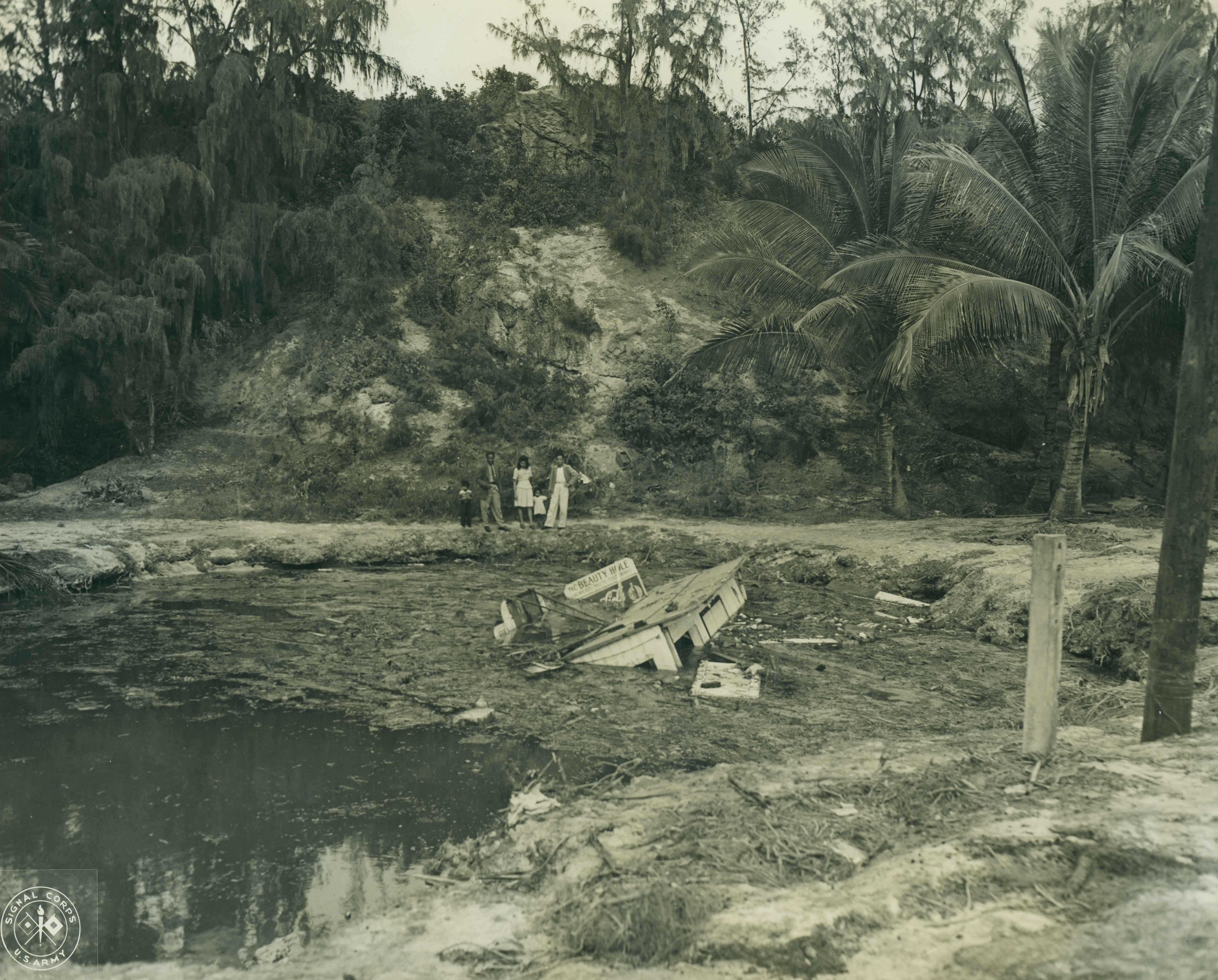
The “Beauty Hole” following the April 1, 1946 tsunami
Over by the Beauty Hole, which was a popular local swimming spot, the wave lifted a building and placed it right in the middle of the swimming hole. After that, the kids would jump in, swim out and climb up on the roof. “We would take a stick and push on the rocks,” Gladys explained, “and push that building around.” The wreckage stayed there for quite some time before they figured out how to dismantle it and pull it out.
As much as I would have loved spending more time with Joe, Laverne and Gladys, our time together soon came to an end. It is important to note that these stories were childhood memories from long ago. Although care was taken to confirm the historical events, in the end, these blogs are meant to highlight the perceptions and attitudes of the times. I am indebted to these honored kupunas for their generosity and support. Their love for their families, their heritage and their beautiful Laie is strong and true. It has been an honor to share their stories.
PREVIOUS SEGMENTS:
SEGMENT ONE: Laie: Finding Refuge From the Storm
SEGMENT TWO: Laie Under Martial Law: The Military Takes Charge
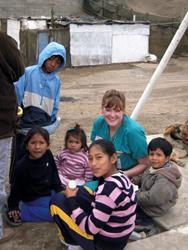
Nina Jones, a mainland gal from way back, is now a transplanted Islander. With her husband of 39 years, she volunteers at the Polynesian Cultural Center. Her hobbies include swimming, traveling, studying and writing about what she is learning from the various Polynesian cultures. Her blogs focus on their history, beliefs, practices and – as an added bonus – delicious food! To her, Polynesia is not just a place to visit, it is a way to live and she is very honored to be able to be a part of their amazing world.

Recent Comments